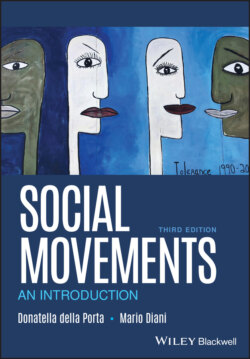Читать книгу Social Movements - Donatella della Porta - Страница 33
2.4.4 Movements of the Crisis?
ОглавлениеWhen looking at anti‐austerity protests we should consider that they developed in a situation of crisis that took different characteristics at national (and also subnational) level. The Global Justice Movement and the anti‐austerity protests were both addressing neoliberal capitalism but in different moments. Research on the labor movement has often looked at waves of strikes, singling out that picks of protest are usually recorded in times of full employment when the workers are structurally stronger. Moreover, economic growth also implies higher margins for investing profits in increase in salaries and taxes to support welfare expenses. By contrast, in times of economic crisis, unemployment hinders the capacity for struggling for improved salaries and working conditions as well as the resources available for state interventions. Strikes are therefore expected to decline and, when called for, they are more likely to be defensive than proactive (Franzosi 2004).
Also in social movement studies, a distinction has been made between movements of abundance and movements of crisis. In general, social movement studies have considered crisis as particularly unfriendly for social movements. The best that they expect was what Kerbo (1982) called long time ago movements of crisis, which he compared with the movements of abundance, as, for example, the movements from the 1960s and 1970s. In his analysis movements of affluence are to be found in relatively good times; they are often formed mainly by conscience members, and they are better organized and less likely to use violence (Kerbo 1982, p. 654). In contrast, movements of crisis are sparked by unemployment, food shortages, and dislocations, when everyday life is challenged during threatening political and social crises. Their participants are, at least in the early stages, mainly the beneficiaries of the requested changes, and protests tend to be more spontaneous, more often involving violent outbursts. In general, while movements of abundance (and opportunities) are expected to be stronger, larger, longer‐lasting, pragmatic, optimistic, and more often successful, movements of crisis (and threats) are expected to be weaker, smaller, shorter, radical, pessimistic, and more often unsuccessful (della Porta 2013). In this vision, movements of crisis are conceptualized, in a way resonant of Polany, as mainly reactive types of mobilization: weakly organized, they do not have many resources for mobilization. Additionally, they would tend to be more violent and more pessimistic. They would mobilize the affected: not a large supportive constituency, but rather those who are more discontent as the unemployed who is hit in the great recession. Moreover, they have been presented as destined to fail in their attempt to resist changes.
Research on the labor movement has linked different types of mobilizations to these alternations between affluence and crisis. In fact, especially in moments of crisis, legitimacy enters in tension with profitability, so that
Efforts to overcome the tendency toward a crisis of legitimacy through improving the condition of the working class as a whole (rising wages, improved working conditions, social welfare provisions) can only work for short amounts of time or small segments of the working class without provoking a crisis of profitability. If the crisis of global capitalism of the 1970s was largely precipitated by a squeeze on profitability, the current global crisis of capitalism is increasingly characterized by a deep crisis of legitimacy as inequality mushrooms and growing numbers have lost access to the means to produce their own livelihood without being provided with any opportunity to make a living within the circuits of capital.
(Silver and Karataşlı 2015, p. 140)
While comparative analyses of social movements in the European periphery show that it was exactly where the crisis was stronger that it triggered higher levels of activities with new repertoires of action as well as organizational forms and claims, and even able to achieve political success, the reflection on the different challenges for contentious actors in times of abundance versus times of crisis remains relevant (della Porta 2017a and 2017b). As some research on labor activism has pointed at, moment of crisis can indeed trigger the creation of resources of solidarity during protests. The long strikes or the factory occupations, as the camping in the squares or the pickets of the unemployed, that characterized the anti‐austerity protests, should be indeed analyzed as reaction to the crisis that then creates innovative ideas and practices (della Porta 2015a). Gramsci’s organic crises, as crises of hegemony of the ruling class, tend indeed to fuel local militancy that can then converge in campaigns and movement projects (Cox and Nielsen 2013).
Indeed, research on the protests during the Great Recession at the European peripheries singled out several differences. In particular, while Polanyi’s type of countermovements mobilized everywhere, it has been where the socioeconomic crisis had more disruptive effects on the everyday life of the citizens that movements with more innovative characters have emerged. In particular, in countries like Iceland, Greece, and Spain, anti‐austerity protests went well beyond the claims for recovering old rights, developing instead a critique of the hollowing out of social protection, but also of the way in which the welfare state had developed. The very concept of the “common good,” as different from both private and public ones, pointed at the need for citizens’ participation in the definition and implementation of their own rights. Also, while popular sovereignty was claimed back for citizens, there were also attempts to broaden the concept of citizenship to go well beyond the members of the nation. Including also traditional organizations, anti‐austerity protest in these countries invented new collective performances which, as the protest camps, aimed at experimenting with alternative forms of democracy (della Porta 2015a; della Porta, Andretta et al. 2016).
